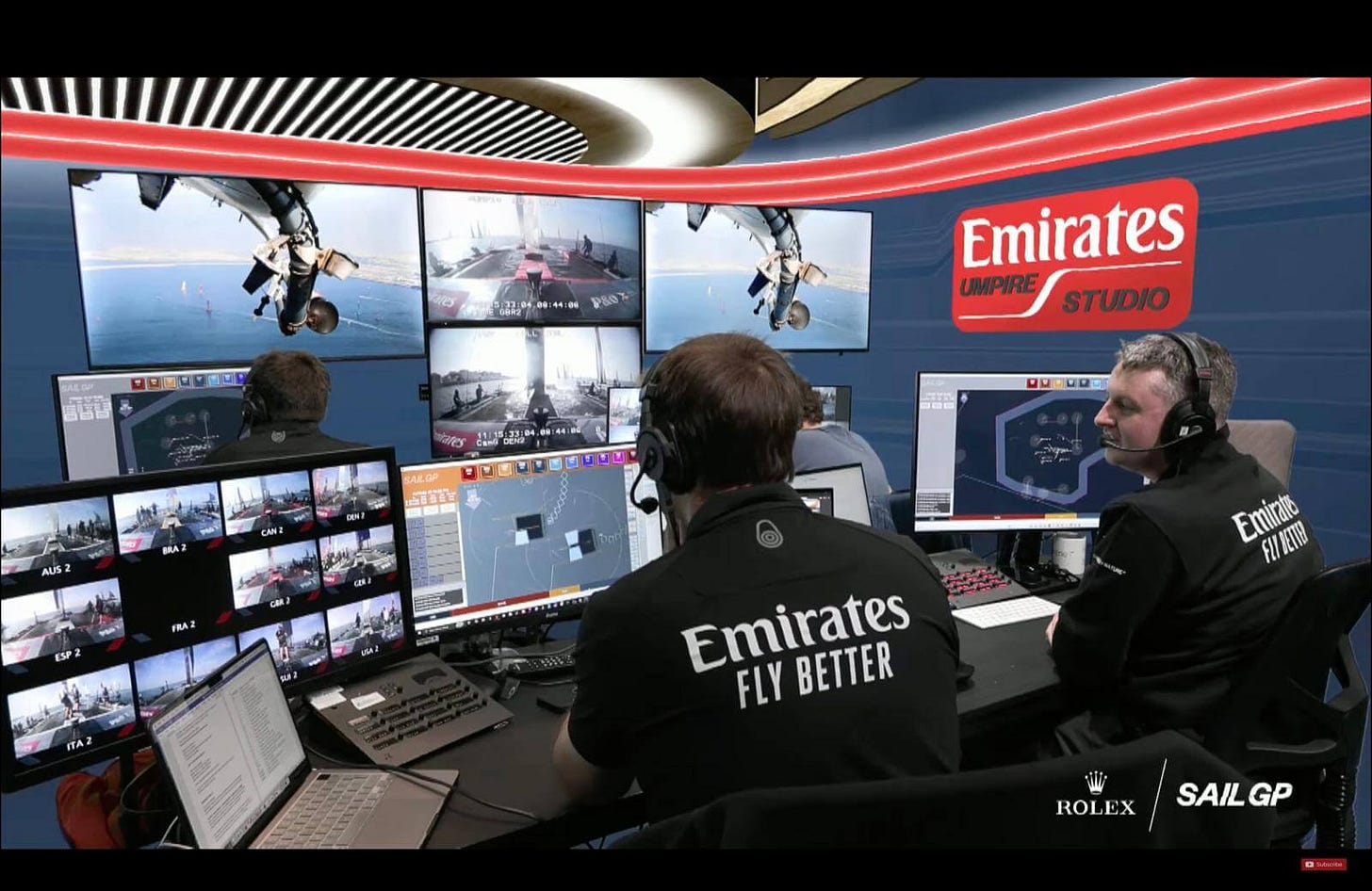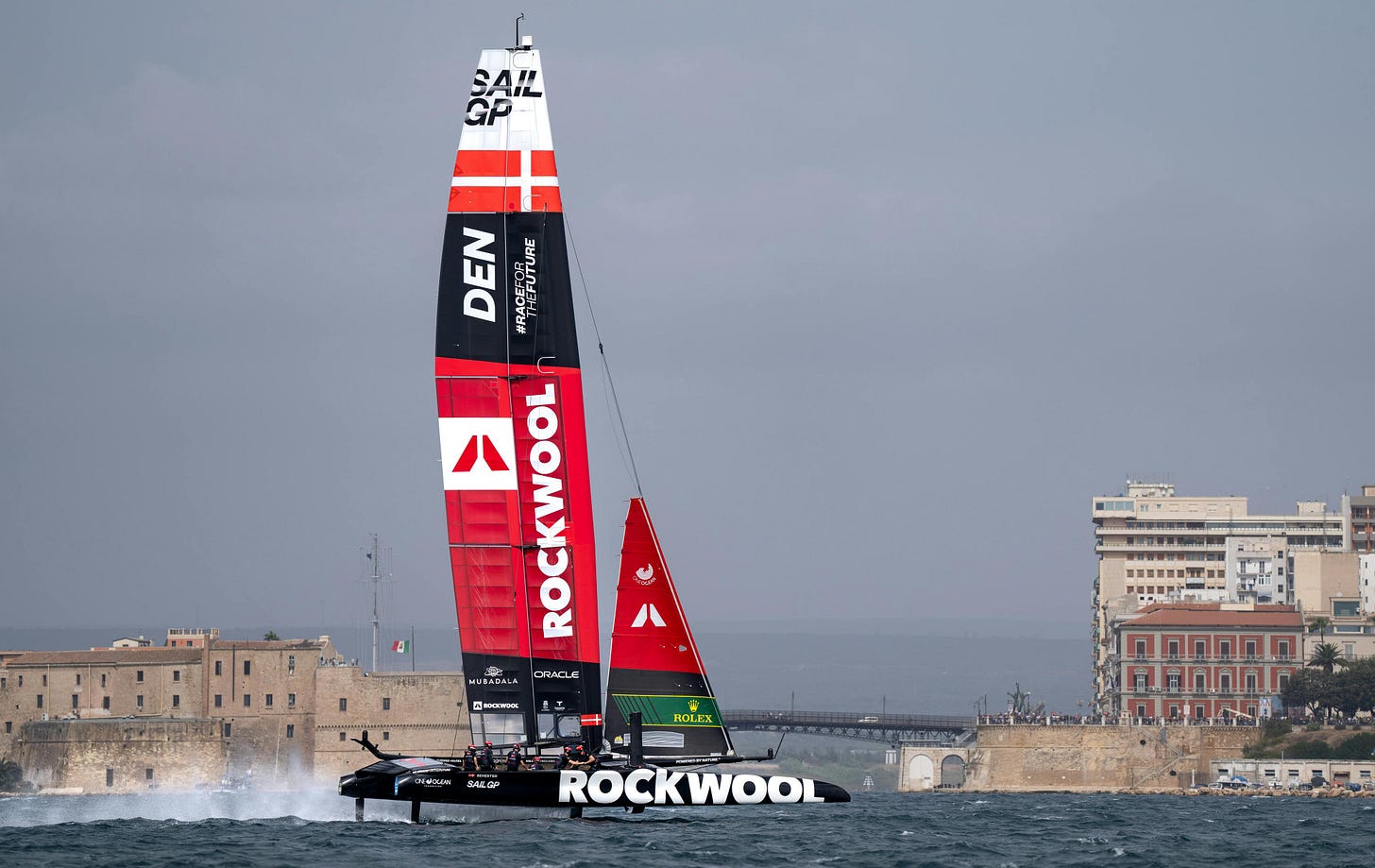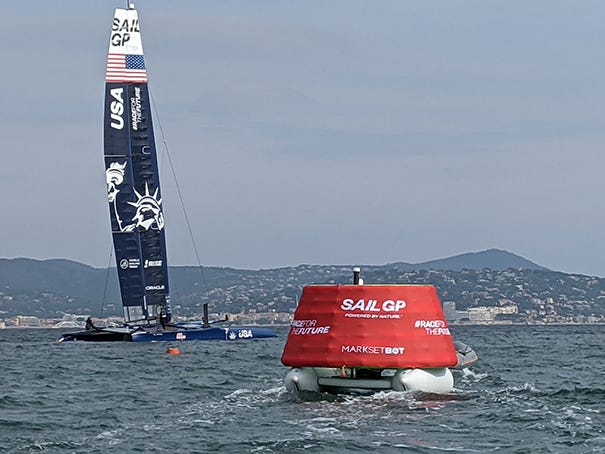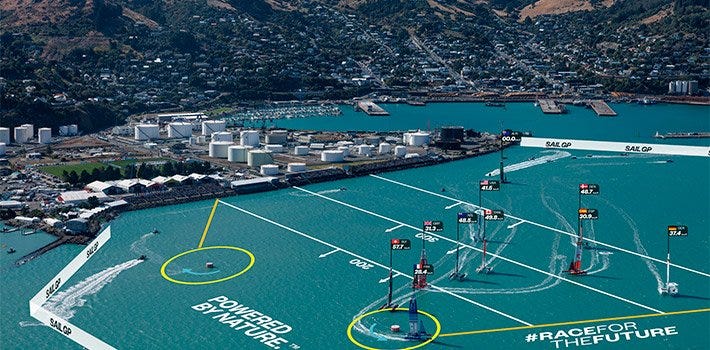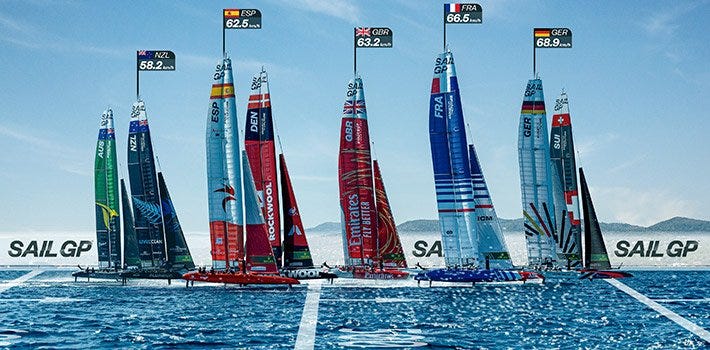The Future of Sports Broadcasting
SailGP’s 5G, AI, and IoT Blueprint
You are receiving this email because you subscribed to Business of Speed, the newsletter for those wanting to stay ahead on what’s happening behind the scenes. I’m Vincenzo Landino, a business, tech, and F1 commentator. I’ve spent the last ten years at the intersection of content, partnerships, and the business of motorsport. This newsletter is where I break down what’s working, what’s shifting, and what’s next without the PR gloss. Thank you for being here.
Let’s start with a simple idea: the ocean is messy.
Winds shift. Currents swirl. Boats fly. Cameras shake. And for decades, broadcasters did their best to capture the chaos with helicopters, long lenses, and a lot of hope.
SailGP didn’t accept that. They engineered it.
What they’ve built over the past two seasons is not just a better broadcast, it’s become a full-stack rethink of how live sports are captured, analyzed, and experienced.
And they’re doing it on water.
Think private 5G sliced for critical telemetry, AI that predicts the next shot before a human can, IoT sensors mounted on both boats and buoys, and a cloud backbone that processes hundreds of thousands of data points per second.
It’s the closest thing sports has to turning a natural environment into an intelligent, responsive, broadcast-ready arena.
Here’s the playbook.
Private 5G as Your Production Truck
Traditional maritime broadcasts work on 10–30 Mbps uplinks. That’s enough for a couple of HD feeds if the weather gods are kind. SailGP and T-Mobile took a different approach—building a hybrid of public 5G Standalone and private 5G on-site, then optimizing it with network slicing to ensure every critical data stream receives guaranteed performance.
Multiple network slices, including telemetry, broadcast video, AR/VR fan layers, and operations, each get their own lane. No elbowing for bandwidth. No dropped frames when two boats nearly collide.
Throughput that matters: enough capacity to run 16+ HD streams simultaneously, including underwater cameras mounted to hydrofoils and buoy-mounted POVs.
Latency that changes storytelling: sub-second roundtrips from the middle of the bay to shore-side edge compute and up to the cloud. That’s the difference between “we missed it” and “we saw it coming.”
If you’re a racing person, think of it like swapping a generic pit lane for your own dedicated, optimized, perfectly staffed box. Except it’s wireless, over water, and feeds an entire TV network.
Cloud + Stream Analytics + Anomaly Detection
Boats are now rolling supercomputers. Each SailGP F50 throws off a firehose of telemetry: attitude, pitch, foil load, jib trim, sailor biometrics, true wind, apparent wind, surface temp across 100+ sensors per boat. Roll nine boats together and you’re north of 200,000 data points per second.
You can’t FTP that. You need a streaming brain.
Stream analytics windows in hundreds of milliseconds, not minutes—turning raw data into meaningful TV graphics, team dashboards, and safety alerts.
Anomaly detection models run on top: pressure sensors trending out of bounds, hydraulics behaving erratically, and angle-of-attack patterns that indicate “this foil is about to complain.” Swap the part before it fails. Keep the show moving.
Dedicated fiber from venue to cloud (FastConnect style) so production isn’t held hostage by the public internet.
This is the quiet superpower. Fans see a beautiful graphic package with a touch of sail-nut detail. Teams see reliability and strategic clarity. Producers see smooth show control with fewer fire drills.
Autonomous Buoys As Camera Operators
Here’s where it gets wild. Those orange “marks” dotting the course? They’re not just markers. They’re autonomous, connected robots with environmental sensors, GPS station-keeping, and onboard cameras.
They reposition themselves as the race committee redraws the geometry. No chase boat crews. No human anchoring. Just push a new coordinate, and the mark moves.
They collect environmental data constantly and feed that into AI models and broadcast graphics. Now your “gust line” on screen isn’t a guess.
And they film. Those “how did they get that angle?” shots when a boat knifes close to a gate? That’s a mark cam on a private 5G slice with predictive AI keeping the subject framed.
Every venue gets a portable, intelligent, self-healing camera and sensor network on the water.
AI That Predicts Action Before It Happens
Ask any director: the hardest part of live sport isn’t reacting, it’s anticipating. SailGP’s answer is machine learning that reads the playbook.
Predictive framing: AI models trained on sailing dynamics see two boats converging on starboard/port long before an intern can shout “collision course.” Cameras swing, drones move, buoy cams wake up, and the moment is captured from three angles.
Capsize and near-miss detection: when heel angles and sail load spike past thresholds, the system flags high-drama sequences proactively. Production rolls replays while the boat is still recovering.
Athlete ID: helmeted sailors, chaotic spray, moving boats—still, models differentiate crew by gait, reach, and position. Lower-third graphics pop without a stage manager playing whack-a-mole.
This is the “moneyball” of live direction: an algorithm co-pilot that quietly raises your batting average on every critical shot.
From Expert-Only To “I Get It”
Sailing is notoriously hard to parse on TV. Rules, right-of-way, invisible wind—that’s a heavy lift for casual fans. Now watch what happens when you layer live data with design.
LiveLine-style overlays make the invisible visible: laylines, zones, right-of-way arcs, penalties. You don’t need a judge in your ear to follow a protest—you see the advantage swing in real time.
The environmental context becomes narrative: watch wind lines ripple across the course, see currents push boats sideways, and understand why the leader just split the gate.
Multi-angle becomes multi-purpose: underwater foil cams for visceral speed, mark cams for geometry, onboard cams for chaos, and drones for grandeur—each chosen by AI for the right moment.
And because 5G keeps fan layers snappy, you can push second-screen control to the couch: pick a boat, lock a camera, layer your own data stack, feel like you’re directing your own show.
Why This Matters Beyond Cool Tech
The value of rights goes up when your show is consistently elite. Consistent elite is a function of systems. Safety improves when anomalies are detected before catastrophic failures occur. That protects athletes and schedules.
Sponsorship inventory expands when you can create premium, data-driven content packages; “presented by” overlays, interactive lenses, camera feeds that literally wouldn’t exist without the partner’s tech.
And here’s the kicker: the same stack works outside sports. Ports. Shipping. Offshore wind. Ocean science. Whenever someone figures out a platform that makes the world safer, faster, or smarter, there’s a second market waiting.
Connectivity isn’t an IT expense; it’s a competitive edge. When you deploy private 5G with network slicing, you stop playing defense—hoping the stream holds—and start creating entirely new experiences.
That shift unlocks a different production philosophy, too: you build for moments, not minutes. AI becomes your co-pilot, quietly hunting for the 2 percent of action that drives 90 percent of social engagement and making sure you never miss it. But the magic really happens when the venue itself becomes intelligent. Instrument the environment, think autonomous buoys and responsive infrastructure, and suddenly the course or track behaves like a programmable arena, tuned to the story you want to tell. In that context, data becomes clairty.
The right overlay at the right time makes the invisible obvious, lowers cognitive load, and turns experts into better storytellers while pulling casuals closer. And through it all, portability is the multiplier. The stack that sings in Sydney should travel effortlessly to New York’s riverfront, a Formula E street circuit, or a mountain downhill line, delivering the same premium, predictable experience everywhere speed comes to life.
The Takeaway
SailGP found a way to fuse 5G, AI, IoT, and cloud into a cohesive, field-proven performance system that makes water behave like a predictable stadium without losing the magic of speed and risk.
That’s the blueprint.
Not because everyone should copy sailing, but because every sport and every premium live experience can learn from how they aligned incentives across tech partners, rights holders, athletes, and fans.
Make it faster. Make it smarter. Make it unmistakably premium.
Then do it again next weekend in a different city, on a different body of water, with the same level of excellence.
That’s the new business of speed.
Business of Speed breaks down the tech, strategy, and partnerships turning speed sports into billion-dollar entertainment. Forward this to someone who needs to see how SailGP just built the blueprint for the future of live sports.


